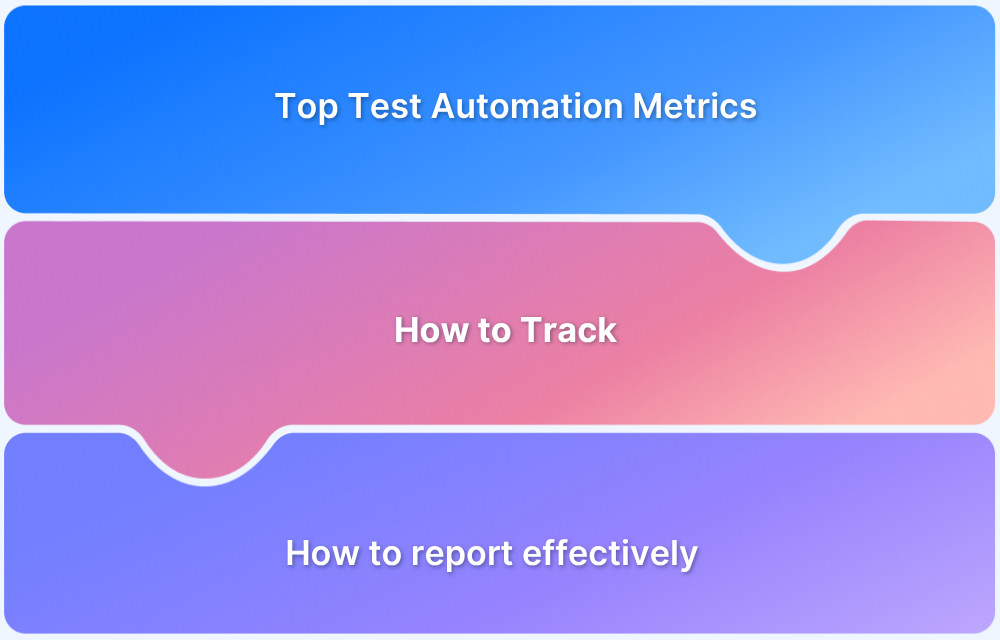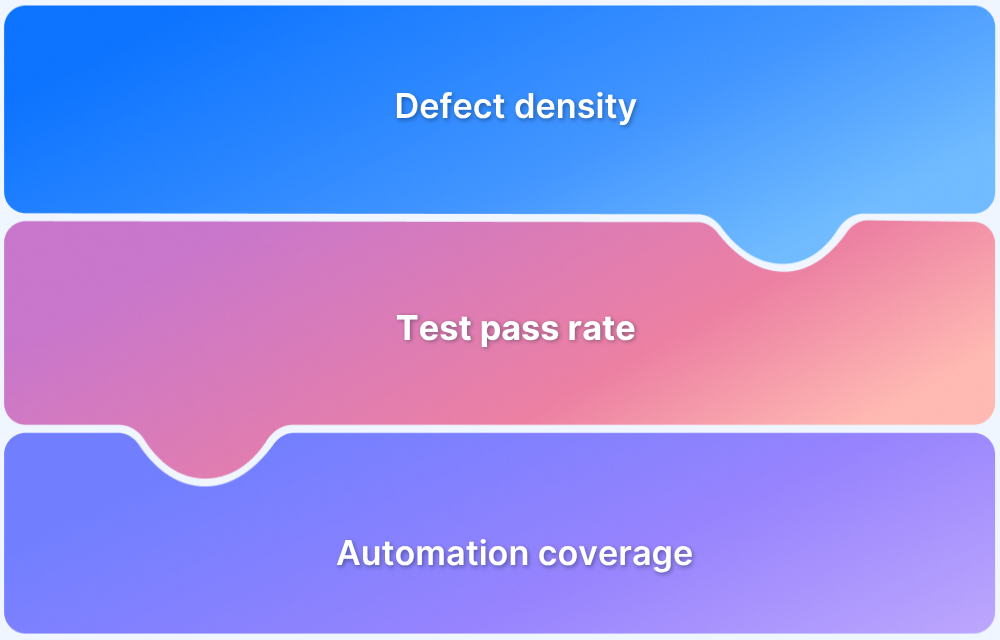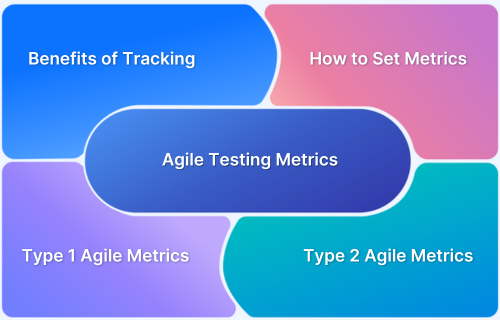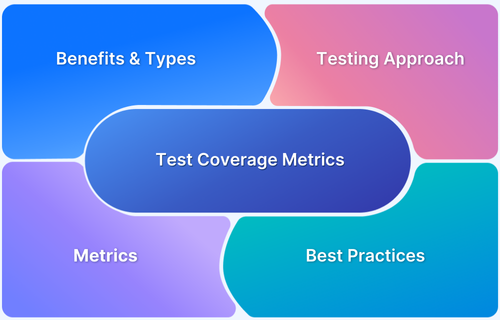Many testing teams struggle to measure the true effectiveness of their automation efforts. Without the right insights, managers risk overlooking inefficiencies, bottlenecks, and quality gaps. Test automation metrics solve this challenge by providing measurable data that helps track progress, optimize resources, and align testing outcomes with business goals.
Overview
Test automation metrics are measurable indicators that evaluate the effectiveness, efficiency, and impact of automation efforts in software testing.
Key Test Automation Metrics:
- Automatable Test Cases: Percentage of test cases that can realistically be automated.
- Automation Script Effectiveness: Ratio of passed scripts to total executed scripts, showing script reliability.
- Automation Pass Rate: Percentage of test runs that successfully pass, reflecting automation accuracy.
- Automation Execution Time: It is the time taken for automated test suites to run, indicating efficiency.
- Automation Test Coverage: Extent to which automated tests cover application features or code.
- Build Stability: Frequency of successful builds after automation execution.
- Automation Pyramid: Balance of unit, integration, and UI tests in the automation strategy.
- Defect Density: Number of defects per unit of code or test size, highlighting quality gaps.
- Defect Resolution Percentage: Percentage of defects resolved against defects identified.
- Defect Age: Average time taken to fix reported defects.
- ROI of Testing: Cost savings and value gained from test automation compared to manual testing.
This article explores the most important test automation metrics that every manager should track to maximize efficiency, ensure quality, and drive measurable outcomes.
Testing Metrics for Agile Testing that every Tester must know
While there are a plethora of metrics that can be used by a test manager, there are some that are particularly relevant for the automation testing process
1. Automatable Test Cases
This is a measure of the percentage of test cases that can be automated with respect to the total number of test cases in a suite. This metric can help identify areas for prioritising automation, as well as areas, which cannot do without human supervision.
It helps in formulating the right testing strategy and creating a balance between manual and automated testing. Here’s how you can calculate the Automatable Test Cases.
Automatable Test Cases = (no. of automatable tests / no. of total tests) * 100
2. Automation Script Effectiveness
This metric is typically geared towards regression testing. It is a percentage value of the ratio of defects found through automation testing as compared to the total number of defects opened in a test management system for a project. It helps to understand the kind of defects which the scripts are unable to unearth and how different environments can influence script efficiency. This can provide a very low-hanging solution to how effective some scripts.
Automation Script Effectiveness = (no. of defects found by automation / no. of defects opened) * 100
3. Automation Pass Rate
This is a more straightforward metric that calculates the number of automation tests that have passed. Not only is it important in the terms that a low failure rate means that the logic behind the script is correct and there are less bugs to fix, but also in understanding whether there are false failures. In the latter case, it can be a signal that the automation scripts are not reliable and need to be recalibrated.
Automation Pass Rate = (no. of cases that passed / no. of test cases executed) * 100
4. Automation Execution Time
This is a simple indication of the time taken by the automation suite to execute from beginning to end. This is key in identifying whether the automation suite constructed generates sufficient ROI as a script that takes too long to run might end up delaying production.
If the automation execution time seems to be of an unacceptable order, the team can leverage the power of Parallel Testing to speed up the process. This means that testers should be able to run multiple tests on multiple devices simultaneously. This cuts down on test time, expedites results, and offers results within shorter deadlines
Using BrowserStack Cloud Selenium Grid, testers can run tests on different browser-device combinations simultaneously by leveraging Parallel Testing.
Use Parallel Test Calculator to check out how how parallel testing can help you achieve your test coverage and build execution time goals.
5. Automation Test Coverage
Test coverage is a black-box technique that monitors the number of test cases executed. In terms of automation testing, this metric helps a team to understand the amount of testing currently being done in an automated manner and identify areas for improvement.
For e.g. Visual Testing, sometimes called visual UI testing, verifies that the software user interface (UI) appears correctly to all users. This has been traditionally done using manual methods, as there was a dearth of test management tools to monitor this process to any degree of fidelity.
However, tools like Percy by BrowserStack has become one of the best-known tools for automating visual testing. It captures screenshots, compares them against the baseline images, and highlights visual changes. With increased visual coverage, teams can deploy code changes with confidence with every commit.
This metric could lead to investigative analysis that results in the adoption of new tools to increase automated test coverage.
6. Build Stability
If automation testing has been incorporated in a CI/CD pipeline, this metric can be leveraged to gauge the efficacy of the tests by calculating the ratio of broken builds to stable ones. This gives a clear idea of the robustness of the tests implemented, and whether they are sufficient to ensure a stable build is pushed to production.
Build Stability = (no. of build failures / no. of builds) * 100
7. Automation Pyramid
This metric/visualisation is based on the popular testing pyramid model used for QA worldwide. There needs to be a consensus among QA leaders about what amount of tests should be automated at each stage of the testing pyramid.
Depending on the amount of automation test coverage and the testing pyramid strategy ideated by the QA management, the automation pyramid can be realigned to suit business needs.
Automation at each level of Pyramid = (no. of tests at each level / no. of total tests) * 100
8. Defect Density
Defect Density is a software quality metric that measures the number of defects (bugs or issues) found in a software application relative to its size, typically in terms of lines of code (LOC) or function points.
It helps assess the quality of the code and provides insight into how many issues exist within a given portion of the software. A lower defect density indicates a more stable and reliable product, while a higher defect density suggests that there may be underlying problems in the development or testing processes.
The formula to calculate Defect Density is:
Defect Density = Number of Defects / Size of the Software (i.e. Lines of Code or Function Points)
9. Defect Resolution Percentage
The defect resolution percentage measures the proportion of identified defects that have been fixed. This is a key indicator of the development team’s ability to address and fix issues.
It’s calculated as:
Defect Resolution Percentage = (Defects resolved / Total defects identified) * 100
10. Defect Age
Defect age refers to the amount of time taken to resolve a defect from the moment it is identified. This metric highlights delays in the defect resolution process and can help pinpoint areas where improvements are needed to speed up bug fixing.
It’s calculated by
Defect Age = Difference between when the Defect was logged and when Defect was resolved.
11. ROI of Testing
The return on investment (ROI) of testing evaluates the financial value testing adds to the overall software development process. It helps teams assess whether the cost of testing is justified by the benefits it delivers, such as improved quality and reduced defects.
It’s calculated as:
ROI of Testing = (Benefits from testing – Cost of testing) / Cost of testing * 100.
Read More: Calculating Test Automation ROI: A Guide
What is Automation Testing?
Automation testing is the process of using specialized tools and scripts to automatically execute test cases, compare actual outcomes with expected results, and report findings.
Unlike manual testing, where testers execute test steps themselves, automation testing speeds up repetitive and complex tasks, reduces human error, and ensures consistent validation across different environments.
It is widely used to enhance test efficiency, accelerate release cycles, and support continuous integration and delivery (CI/CD) pipelines.
What are Software Testing Metrics?
Software Testing Metrics help in tracking the efficiency of a particular Software QA activity. These are the benchmarks that help track the success of the activity in question after the process has finished.
Test automation is often considered to be time-consuming to set up, and expensive in terms of the tools and resources required to successfully execute test suites to completion. Test automation metrics and KPIs can provide a valuable means of determining the ROI for the effort expended into automation and understand key areas for improvement.
However, for this to be correctly gauged, QA Leaders must be able to select the “right” metrics for automation testing.
How to Select the “Right” Testing Metric for Automation
While the choice of automation test metrics depends on the specific team or business case, there are certain fundamental objectives that a metric must fulfill to provide real value:
- Importance to business objectives: Any metric must reflect the primary objective the company strives for. It can be something that affects periodic revenue growth or user acquisition. For more mature organisations, it can be a measure of customer churn. Business objectives will vary on an organisational basis and thus, these need to be tailored accordingly.
- Provide room for improvement: Every chosen metric should allow the organisation to weed out sub optimality and improve on an incremental basis. A baseline value should be decided upon, and the metric should demonstrate progress based on the same. E.g. Time to register could be set at a particular value, and the metric can be manipulated to maintain that state.
- Provides input for strategy: A metric should be useful for mapping the overarching strategy for the organisation. It should not only deliver a baseline signal, but also inspire the team to formulate a plan and seek relevant questions.
- Easily executable: Having too complex a metric like “Test Relevance” can be confusing to both implement and explain. It can be simpler to create bite-sized metrics that are intuitive and can be summed up to explain the bigger picture.
Read More: What is Reliability Software Testing
Why use BrowserStack Automate for Test Automation?
BrowserStack Automate is a cloud-based testing platform that helps teams test their apps across different devices and browsers. It’s a great tool for Test Automation because it ensures comprehensive testing experience.
Some of the notable features include:
- Real Devices: Test apps on 3500+ real devices and browsers without needing your own lab.
- Easy Integration: Works with popular CI/CD tools like Jenkins, GitHub Actions, and Azure DevOps to automate testing in your pipeline.
- Faster Testing: Run multiple tests at the same time to save time and speed up delivery.
- Thorough Testing: Test everything from functionality to performance and visual appearance.
- Supports Gradual Rollouts: Helps test canary releases and feature toggles in real user conditions.
- Simulated Real-World Scenarios: Provides a realistic environment for testing, ensuring apps work flawlessly across different devices and configurations.
Track Test Automation Metrics with Test Management
BrowserStack Test Management is a centralized dashboard that helps manage test suits including both Automation and Manual Test Cases. Using Test Management tool help track test automation metrics for ensuring effective, organized, and efficient software testing.
- Centralized Visibility: Test management tools provide a single platform to monitor and analyze test automation metrics, offering clear insights into test performance and coverage.
- Improved Collaboration: They enable seamless communication between teams by sharing test results and metrics, helping identify and address issues quickly.
- Efficient Tracking: Test management systems help organize and schedule automated tests, ensuring consistent execution and reducing the risk of missed tests.
- Trend Analysis: Tracking metrics over time allows teams to identify patterns, address recurring issues, and optimize automation processes for continuous improvement.
- Integration with CI/CD: Test management tools integrate with CI/CD pipelines, providing real-time tracking of automated tests and aligning testing with development cycles.
Conclusion
Automation tests have become integrated into agile testing models as well as CI/CD Pipelines in a manner that every company worth its salt has invested time and effort to set up comprehensive automation test suites to expedite its testing process.
The entire QA process hinges on the use of a real device cloud. It is impossible to identify every possible bug a user may encounter without real device testing. Moreover, QA metrics cannot set baselines and measure success without procuring accurate information on bugs. It stands true for manual testing as well as automation testing.
BrowserStack’s real device cloud provides 3500+ real browsers and devices for an instant, on-demand testing. The cloud also provides integrations with popular CI/CD tools such as Jira, Jenkins, TeamCity, Travis CI, etc. Additionally, built-in debugging tools let testers identify and resolve bugs immediately.






